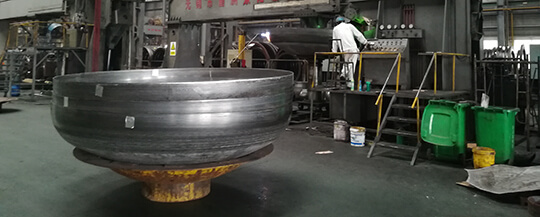Regarding the forging process of the integral head of the reactor pressure vessel, from the information available, only three Japanese companies abroad have proposed the forming process for the integrated head of the nuclear electric pressure vessel. Namely Japan Cast and Forged Steel (JCFC), Kobe Steel Works (KSL) and Japan Steel Works (JSW). Among them, the forging processes of JCFC and KSL are relatively close, which can be attributed to a class of processes. They all form the flange part first, and then stretch to form the spherical head part. The KSL process differs from it only in that in the first step, only a flat-bottom basin is forged, and the lower part does not need to use a cushion mold. But the price is that the amount of machining before the stretch head is much larger than the JCFC process. The characteristic of JSW's process is to place the forging blank in a hemispherical die and press it by the rotation of the meniscus punch. The spherical head part is formed first, and the flange part is initially formed, and then the final flange part is formed by trimming. During this period, the upper and lower convex and concave dies need several sets to adapt to the control of the shape of the forging at different deformation stages. It should be particularly noted that, in order to avoid excessive rotation quality, the JSW process does not use the rotary table forging method, but fixes the forging blank and die on the immovable table of the hydraulic press, and designs and manufactures the half moon that can rotate 360° The plate punch, the meniscus punch is fixed on the beam, and the forging is forged by rotating the pressure. The process greatly reduces the rotation quality, and is easy to fix the rotation center axis, and can greatly improve the forging accuracy of axisymmetric spherical head forgings.
The domestic research on large integral heads only started in the new century. In 2005, Ren Yunlai proposed to form integral heads with partial die rotary forging, and studied the influence of die structure on the forming of the heads, analyzed the reasons and Optimize mold structure parameters. In 2008, Yang Xiaoyu proposed the integral rotary forging method to form a super large head. In 2009, Jiang Tao proposed a two-step overall forging process for disc making, using finite element method to numerically simulate the forging forming, and verify the forming process with physical simulation (ratio 1:5). In the same year, Wang Chengpeng used finite element simulation to study the formation of cracks and cavity expansion during the forming process of large flanged heads, which provided a reference for the prediction of the microstructure of large forgings. In 2011, Liu Pan used the numerical model of successively rotating equal down-pressure method to form extra-large thick-walled heads.
